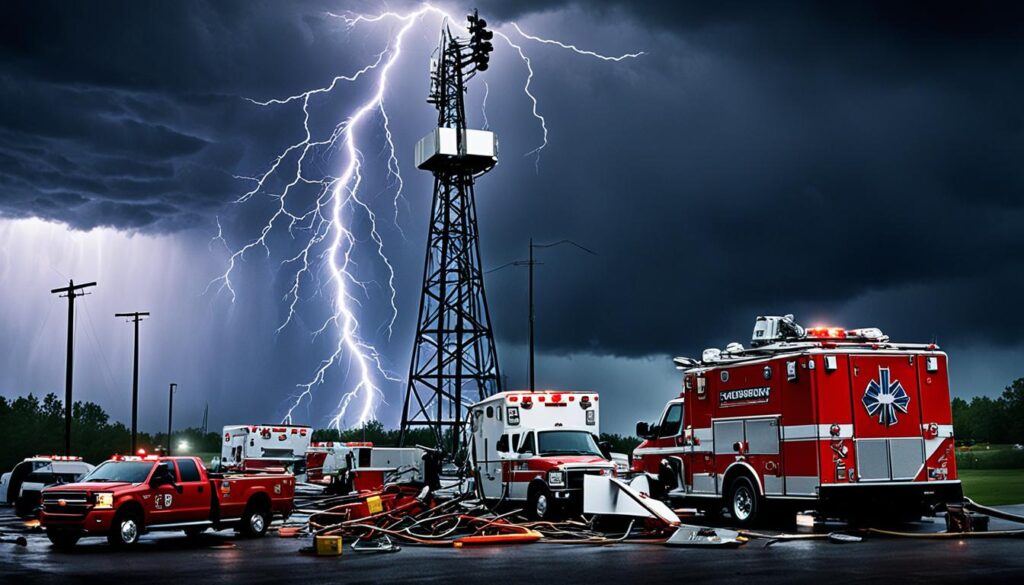Did you know that a single natural disaster or cyberattack can bring down an entire IPTV network, disrupting the service for thousands or even millions of viewers? The scale of potential disruptions underscores the critical need for robust disaster recovery strategies in the IPTV industry.
In this article, we will explore the best practices and tips for implementing effective IPTV network disaster recovery plans. From assessing risks to preparing backups, implementing redundancy, monitoring performance, executing the plan, and reviewing the results, we will cover all the essential steps to ensure the continuity of IPTV services even in the face of unexpected challenges.
Key Takeaways:
- Disasters pose significant risks to IPTV networks, impacting service availability and customer satisfaction.
- Assessing risks, preparing backups, and implementing redundancy are crucial steps in IPTV network disaster recovery planning.
- Monitoring network performance and executing a well-defined plan are essential for timely service restoration.
- Reviewing the results and continuously updating the disaster recovery plan help adapt to changing circumstances.
- An effective disaster recovery plan minimizes downtime, protects reputation, and ensures business continuity in the IPTV industry.
Assessing Risks in IPTV Network Disaster Recovery
When it comes to disaster recovery plans for IPTV, it is crucial to begin by assessing the potential risks that could impact the network’s continuity. By identifying these risks, IPTV service providers can develop effective strategies to minimize the impact and ensure uninterrupted service for their customers.
The first category of risks to consider are natural disasters. These can include events such as floods, severe storms, earthquakes, and power outages. By evaluating the likelihood, impact, and duration of these events, IPTV providers can determine the level of risk associated with each and prioritize their disaster recovery efforts accordingly.
Preparing Backups for IPTV Network Disaster Recovery
In order to ensure a robust and reliable IPTV network, it is crucial to have a comprehensive backup plan in place. This involves preparing backups for both data and hardware components, allowing for swift recovery in the event of a disaster. Let’s explore the key considerations and best practices for IPTV network backups.
1. Data Backups
When it comes to data backups, it is essential to secure important information such as program guides and subscriber data. These backups serve as a safeguard against data loss and facilitate the smooth resumption of IPTV services. To ensure the effectiveness of data backups, regular testing should be conducted to verify their functionality. In addition, backups should be stored securely off-site or in the cloud to mitigate the risk of physical damage or data theft.
2. Hardware Backups
Hardware backups play a critical role in IPTV network disaster recovery. By having spare devices and power supplies readily available, network operators can quickly replace faulty components and minimize service downtime. It is important to maintain an inventory of spare hardware and regularly test its functionality to ensure that it can seamlessly integrate into the network when needed.
3. Backup Testing and Maintenance
A backup plan is only effective if backups are regularly tested and maintained. Regularly scheduled tests should be conducted to validate the integrity and functionality of backups. This includes verifying the ability to restore data and ensuring that hardware backups can be seamlessly integrated with the existing network infrastructure. Any issues identified during testing should be promptly addressed to guarantee the availability of reliable backups.
4. Backups Documentation
Accurate documentation is crucial for an effective backup strategy. It is essential to maintain comprehensive records of all backups, including their location, creation date, and relevant details. This documentation serves as a guide during disaster recovery, ensuring that backups are easily accessible and can be promptly deployed in the event of a network failure.
5. Best Practices Summary
To summarize, preparing backups for IPTV network disaster recovery requires a comprehensive approach that encompasses both data and hardware components. By prioritizing data backups, maintaining an inventory of spare hardware, regularly testing and maintaining backups, and documenting the backup strategy, network operators can significantly enhance the resilience and reliability of their IPTV networks.
By following these best practices, IPTV service providers can effectively navigate through various disaster scenarios, minimize service disruptions, and ensure seamless continuity of their IPTV services.
Preparing Backups for IPTV Network Disaster Recovery – Best Practices
| Best Practice | Description |
|---|---|
| Conduct Regular Backup Testing | Regularly test the functionality and reliability of backups to ensure their effectiveness during disaster recovery scenarios. |
| Maintain Spare Hardware | Keep spare devices and power supplies to quickly replace faulty components and minimize service downtime. |
| Store Backups Securely | Store backups in secure off-site or cloud-based locations to protect against physical damage or data theft. |
| Document Backup Strategy | Maintain accurate records of backup details including location, creation date, and any pertinent information. |
By implementing these best practices, IPTV service providers can enhance their disaster recovery capabilities and ensure uninterrupted service delivery for their customers.

Implementing Redundancy in IPTV Network Disaster Recovery
When it comes to disaster recovery planning for IPTV networks, implementing redundancy is a crucial step in ensuring uninterrupted service. By creating multiple paths and sources for delivering the IPTV service, networks can mitigate the risks of failure or outages and enhance their emergency preparedness.
There are various strategies and approaches to implementing redundancy in IPTV networks. Different network architectures, transmission protocols, and content delivery networks can be utilized to provide alternative routes and distribute content closer to end-users. This ensures that even in the event of a disruption, viewers can continue to access IPTV services without interruption.
One strategy for implementing redundancy is the use of failover systems. These systems automatically switch to backup paths or sources if the primary ones encounter issues. By having redundant hardware and network infrastructure in place, IPTV networks can seamlessly transition between primary and backup resources, minimizing downtime and maintaining service continuity.
Another approach to redundancy is the use of load balancing. This involves distributing the network traffic across multiple paths or sources, ensuring that no single component becomes overwhelmed or overloaded. By evenly distributing the workload, load balancing helps improve performance and reliability, reducing the risk of service disruptions.
Additionally, IPTV networks can also leverage the benefits of content delivery networks (CDNs) to enhance redundancy. CDNs store and deliver content from multiple servers located in different geographic locations. This allows for content to be distributed from servers closest to the end-users, reducing latency and minimizing the impact of network failures or congestion.
To further enhance redundancy, IPTV networks should regularly evaluate and assess their failover strategies and emergency preparedness measures. By conducting periodic assessments and testing, any weaknesses or vulnerabilities can be identified and addressed in a timely manner. This iterative approach ensures that the network’s redundancy strategies remain effective and up to date.
By implementing redundancy strategies in IPTV networks, such as failover systems, load balancing, and CDNs, operators can significantly improve their emergency preparedness and minimize the risks of service disruptions. Redundancy not only enhances the reliability and performance of IPTV networks but also provides peace of mind to both operators and viewers.
Benefits of Implementing Redundancy in IPTV Networks:
- Improved service continuity, even during network failures or outages.
- Enhanced reliability and performance of IPTV services.
- Minimized downtime and business impact in the event of a disruption.
- Reduced risk of service interruptions and customer dissatisfaction.
- Greater flexibility and scalability to accommodate changing network demands.

| Redundancy Strategy | Description |
|---|---|
| Failover Systems | Automatically switch to backup paths or sources in case of primary system failures. |
| Load Balancing | Distribute network traffic across multiple paths or sources to improve performance and reliability. |
| Content Delivery Networks (CDNs) | Deliver content from servers located in various geographic locations to reduce latency and minimize network failures or congestion. |
Monitoring Performance in IPTV Network Disaster Recovery
Once the disaster recovery plan for an IPTV network is put into action, it is crucial to continuously monitor the performance of the network to ensure the effectiveness of the recovery strategies. Monitoring involves collecting and analyzing data on various aspects of the network, including:
- Network status: This includes checking the connectivity and availability of the network components, such as servers, routers, and switches.
- Traffic: Monitoring the network traffic helps identify any unusual patterns or spikes in data flow that might indicate a potential issue.
- Quality: Assessing the quality of the IPTV service, such as video and audio playback, ensures that the end-users are experiencing satisfactory performance.
- Availability: Verifying the accessibility of the IPTV service to end-users ensures that they can seamlessly access their favorite programs without interruptions.
Proactive monitoring is essential to identify and resolve any issues that could affect the IPTV service. By promptly detecting and addressing potential problems, it is possible to minimize the impact on the end-users and maintain the quality and availability of the service.
Monitoring Tools and Techniques
To effectively monitor the performance of an IPTV network during disaster recovery, various tools and techniques can be utilized:
- Network Monitoring Software: Implementing specialized network monitoring software allows network administrators to have a comprehensive overview of the network performance, including real-time data and alerts for any anomalies.
- Performance Testing: Regularly conducting performance tests, such as load testing, stress testing, and capacity planning, helps identify potential bottlenecks or limitations in the network infrastructure.
- Real-Time Analytics: Utilizing real-time analytics tools enables the monitoring of network metrics, traffic patterns, and user behavior, providing valuable insights for proactive troubleshooting and optimization.
- Alerts and Notifications: Setting up alerts and notifications for critical performance indicators ensures that any deviations or issues are immediately brought to the attention of the network administrators.
By leveraging these monitoring tools and techniques, IPTV network operators can effectively track the performance of the network during disaster recovery efforts and swiftly address any issues that arise.

| Benefits of Performance Monitoring | Challenges of Performance Monitoring |
|---|---|
|
|
Executing the Plan for IPTV Network Disaster Recovery
Once a disaster strikes, executing the plan for IPTV network disaster recovery is crucial to minimize downtime and restore service promptly. This step involves activating backups, switching to redundant paths or sources, and communicating effectively with all stakeholders.
In order to execute the plan successfully, it is important to:
- Follow the predetermined steps outlined in the disaster recovery plan.
- Activate the necessary backups, whether it is restoring data from backups or deploying spare hardware.
- Implement the redundancy solutions that have been put in place to ensure seamless service continuity.
During the execution phase, clear and timely communication is key. This includes notifying customers about the situation and providing updates on the progress of service restoration. Effective communication with stakeholders, such as technicians and vendors, is also essential to coordinate efforts and resolve any issues promptly.
By executing the plan efficiently and communicating effectively, IPTV networks can minimize the impact of the disaster on their services while maintaining customer satisfaction.

| Execution Guidelines for IPTV Network Disaster Recovery: |
|---|
| 1. Follow the steps outlined in the disaster recovery plan |
| 2. Activate backups and restore data or deploy spare hardware |
| 3. Implement redundancy solutions for service continuity |
| 4. Communicate clearly and promptly with customers and stakeholders |
Reviewing Results of IPTV Network Disaster Recovery
After a disaster, it is crucial to review the results of the IPTV network’s disaster recovery plan. This step allows for evaluating the performance, effectiveness, and efficiency of the plan, while also identifying areas for improvement. Collaborating with IPTV network staff, partners, vendors, customers, stakeholders, and authorities is key to conducting a comprehensive review.
Performance Evaluation
During the review, the performance of the disaster recovery plan should be carefully assessed. It is essential to analyze how well the plan executed its intended functions and whether it met the intended recovery time objectives (RTO) and recovery point objectives (RPO). By evaluating the plan’s performance, potential gaps or shortcomings can be identified and addressed.
Effectiveness and Efficiency Assessment
Measuring the effectiveness and efficiency of the disaster recovery plan is essential in determining its overall success. The effectiveness of the plan refers to how well it achieved its objectives and restored the IPTV service. Meanwhile, the efficiency of the plan relates to the resources utilized during the recovery process, including time, manpower, and financial investments. Assessing both effectiveness and efficiency allows for optimizing the plan’s future implementation.
Identifying Areas for Improvement
Reviewing the results of the disaster recovery plan provides an opportunity to identify areas that can be improved. This includes analyzing any bottlenecks, vulnerabilities, or unanticipated challenges that emerged during the recovery process. By pinpointing these areas, adjustments can be made to enhance the plan’s efficacy and strengthen IPTV emergency preparedness.
Collaboration for Comprehensive Evaluation
To ensure a thorough review, collaboration is crucial. Engaging with IPTV network staff, partners, vendors, customers, stakeholders, and authorities allows for diverse perspectives and insights. By involving all relevant parties, a comprehensive evaluation can be conducted, leading to holistic enhancements in the disaster recovery plan.
| Benefits of Reviewing IPTV Network Disaster Recovery Results |
|---|
| 1. Identifies strengths and weaknesses of the plan |
| 2. Enables improvements for better future performance |
| 3. Enhances collaboration and communication among stakeholders |
| 4. Increases IPTV service recovery options and preparedness |
By diligently reviewing the results of the IPTV network’s disaster recovery plan, organizations can optimize their IPTV emergency preparedness and service recovery options. Addressing performance, effectiveness, efficiency, and identifying areas for improvement, allows for a more robust and resilient disaster recovery plan, ensuring uninterrupted IPTV services even in challenging circumstances.

Importance of a Server Disaster Recovery Plan for IPTV Networks
When it comes to IPTV networks, having a robust server disaster recovery plan is of utmost importance. Such plans play a critical role in mitigating the effects of disasters and ensuring uninterrupted business operations. By implementing disaster recovery strategies, IPTV networks can recover from various types of disasters, including DDoS attacks, natural disasters, power shortages, and hardware malfunctions. Let’s explore why a well-defined server disaster recovery plan is essential for IPTV networks and how it helps protect their reputation and minimize downtime.
The Consequences of Inadequate Disaster Recovery
Failure to have a comprehensive disaster recovery plan in place can lead to severe consequences for IPTV networks. Without proper redundancy solutions, an unexpected disaster can result in prolonged downtime, revenue loss, dissatisfied customers, and damage to the network’s reputation. Considering the high demands and expectations of IPTV customers, it is crucial to be prepared for any potential disruptions or emergencies.
Protecting Business Continuity
A server disaster recovery plan ensures business continuity for IPTV networks. By having pre-defined steps and measures in place, these networks can swiftly recover from disasters and resume normal operations. This allows them to provide uninterrupted service to customers and maintain their competitive edge in the market.
Minimizing Downtime and Losses
Disasters can cause significant downtime and financial losses if not handled efficiently. A well-executed server disaster recovery plan minimizes downtime by swiftly restoring critical services and minimizing impact. By implementing redundancy solutions and backup measures, IPTV networks can reduce the time taken for recovery, ensuring minimal disruption to their operations.
Protecting Reputation and Customer Satisfaction
Customer satisfaction is vital for the success of IPTV networks. A robust server disaster recovery plan helps protect the network’s reputation by showing its commitment to delivering reliable services, even in the face of unforeseen circumstances. By swiftly recovering from disasters, IPTV networks demonstrate their dedication to customer satisfaction and establish trust within their user base.
Ensuring Compliance and Security
A server disaster recovery plan also helps IPTV networks ensure compliance with relevant regulations and security standards. By having a well-documented plan that includes data backup strategies, security measures, and recovery procedures, these networks can address compliance requirements and safeguard sensitive information, enhancing overall network security.
Summary Table – Importance of a Server Disaster Recovery Plan for IPTV Networks
| Benefits | Description |
|---|---|
| Business Continuity | Ensures uninterrupted operations and service delivery |
| Minimized Downtime | Swift recovery and reduced impact on services |
| Reputation Protection | Preserves network reputation and customer satisfaction |
| Compliance and Security | Meets regulatory requirements and enhances network security |
It is evident that a server disaster recovery plan is crucial for the smooth functioning and survival of IPTV networks. By investing in IPTV redundancy solutions and implementing comprehensive disaster recovery plans, these networks can effectively navigate unexpected disruptions, minimize downtime, and protect their reputation. The next section will delve into the key elements of an effective server disaster recovery plan, providing valuable insights into building a resilient infrastructure.
Elements of an Effective Server Disaster Recovery Plan
An effective server disaster recovery plan is essential for ensuring IPTV service continuity and implementing IPTV failover strategies. By incorporating the following key elements, IPTV networks can minimize downtime and maintain a reliable service:
1. Clearly defined recovery time objectives (RTO) and recovery point objectives (RPO)
- Establishing specific targets for the time it takes to recover IT services (RTO) and the amount of data loss acceptable during recovery (RPO) is crucial. These objectives provide a framework for planning and executing efficient recovery operations.
2. IT asset inventories
- Developing comprehensive inventories of all IT assets, including servers, network devices, storage systems, and software, enables efficient tracking, management, and recovery of critical components. This inventory should also include documentation of device configurations and interdependencies.
3. Assigned personnel roles
- Assigning specific responsibilities to qualified personnel ensures a coordinated and effective response during disaster recovery operations. Roles may include team leaders, technicians, communication coordinators, and stakeholders responsible for decision-making.
4. Identification of sensitive documents and data
- Identifying sensitive documents and data, such as customer records, financial information, and intellectual property, allows for the implementation of additional security measures and priorities during the recovery process. Backing up and securing these assets is essential for maintaining business continuity.
5. Offshore backups
- Storing backups in geographically dispersed or offshore locations enhances data protection and recovery capabilities. Offshore backups provide an additional layer of security against regional disasters, geographical disruptions, or localized issues that may impact the primary data center.
6. Disaster recovery sites
- Establishing dedicated disaster recovery sites, equipped with the necessary infrastructure and resources, allows for the quick restoration of IT services in the event of a disaster. These sites should be located at a safe distance from primary data centers to avoid simultaneous disruptions.
7. Response procedures
- Developing well-defined response procedures, including step-by-step instructions for various disaster scenarios, ensures a consistent and efficient recovery process. These procedures should cover system restarts, data restoration, network reconfiguration, and any necessary communication protocols.
8. Communication plan
- Establishing a communication plan that outlines how and when to notify key stakeholders, customers, and employees during a disaster is crucial. This plan should provide clear channels of communication, including emergency contact information, and define the protocols for information dissemination.
Regular testing and updates of the disaster recovery plan are essential to address evolving threats, technology changes, and business requirements. By incorporating these elements into their server disaster recovery plan, IPTV networks can ensure the continuity of their services, mitigate risks, and maintain customer satisfaction.
Types of Disasters Covered in a Server Disaster Recovery Plan
A server disaster recovery plan is essential for IPTV networks to mitigate the impact of various types of emergencies. Let’s explore the different disasters that should be covered in an effective server disaster recovery plan:
- DDoS attacks: These malicious attacks can overwhelm an IPTV network, causing service disruptions and compromising user experience. An effective disaster recovery plan should include measures to mitigate and recover from DDoS attacks, such as traffic filtering and rerouting protocols.
- Natural disasters: Earthquakes, floods, hurricanes, and other natural disasters can result in power outages, infrastructure damage, and service interruptions. By including strategies for handling these events, such as backup power sources and geographically dispersed data centers, IPTV networks can ensure service continuity during difficult times.
- Power shortages: Electricity failures can disrupt IPTV network operations, affecting service availability and delivery. Implementing redundant power systems, such as uninterruptible power supplies (UPS) and backup generators, is crucial to maintain uninterrupted service even during power outages.
- Hardware malfunctions: Equipment failures, such as server crashes or network equipment breakdowns, can have a significant impact on IPTV service delivery. A server disaster recovery plan should include procedures for swift hardware replacement or repair to minimize downtime and restore service quickly.
- Network failures: Network outages, whether due to physical infrastructure issues or software failures, can hamper IPTV service availability. Redundant network architectures, alternative routing protocols, and failover mechanisms are necessary to ensure a seamless transition to backup networks and minimize service disruptions.
By comprehensively addressing these disaster scenarios in a server disaster recovery plan, IPTV networks can effectively respond to emergencies and safeguard their infrastructure, content, and customer experience.
Conclusion
Disaster recovery planning is crucial for IPTV networks to ensure business continuity and customer satisfaction. By assessing risks, preparing backups, implementing redundancy, monitoring performance, executing the plan, and reviewing the results, IPTV networks can effectively recover from disasters and minimize the impact on their services.
During the planning phase, it is important for IPTV networks to carefully assess the potential risks that could disrupt their operations. By identifying and prioritizing critical components, they can develop a comprehensive disaster recovery plan that addresses various scenarios, including natural disasters and cyberattacks.
Regular testing and updating of the disaster recovery plan is essential to adapt to changing circumstances and ensure its effectiveness. By continually monitoring the performance of the IPTV network and proactively addressing any issues, networks can provide reliable and uninterrupted service to their customers.
Overall, implementing a robust disaster recovery plan is an essential part of IPTV network management. By taking the necessary precautions, networks can recover quickly and efficiently from disasters, thereby minimizing downtime, protecting their reputation, and ensuring the satisfaction of their customers.
FAQ
What are the key steps in disaster recovery planning for IPTV networks?
How should risks be evaluated in IPTV network disaster recovery?
What should be included in the backups for the IPTV network?
What is the importance of implementing redundancy in IPTV network disaster recovery?
How should the performance of the IPTV network be monitored during disaster recovery?
What is the role of execution in IPTV network disaster recovery?
Why is it important to review the results of IPTV network disaster recovery?
What is the importance of a server disaster recovery plan for IPTV networks?
What are the key elements of an effective server disaster recovery plan?
What types of disasters should be covered in a server disaster recovery plan for IPTV networks?






